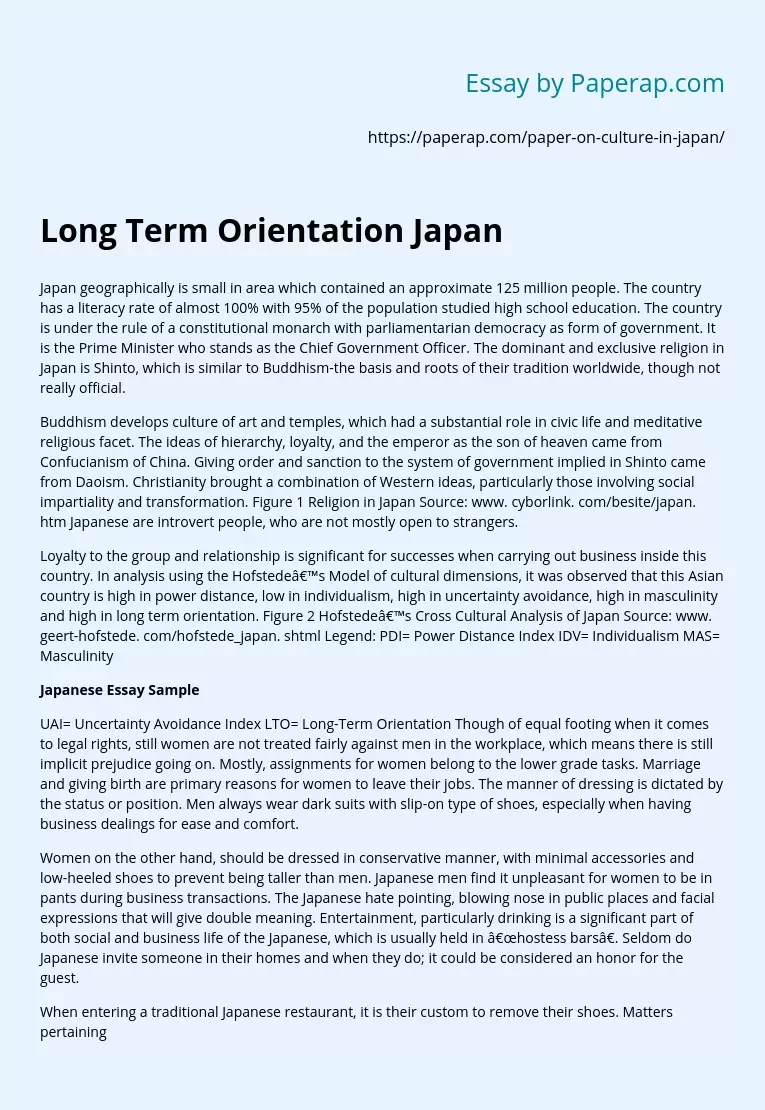Japan geographically is small in area which contained an approximate 125 million people. The country has a literacy rate of almost 100% with 95% of the population studied high school education. The country is under the rule of a constitutional monarch with parliamentarian democracy as form of government. It is the Prime Minister who stands as the Chief Government Officer. The dominant and exclusive religion in Japan is Shinto, which is similar to Buddhism-the basis and roots of their tradition worldwide, though not really official.
Buddhism develops culture of art and temples, which had a substantial role in civic life and meditative religious facet. The ideas of hierarchy, loyalty, and the emperor as the son of heaven came from Confucianism of China. Giving order and sanction to the system of government implied in Shinto came from Daoism. Christianity brought a combination of Western ideas, particularly those involving social impartiality and transformation. Figure 1 Religion in Japan Source: www. cyborlink. com/besite/japan. htm Japanese are introvert people, who are not mostly open to strangers.
Loyalty to the group and relationship is significant for successes when carrying out business inside this country. In analysis using the Hofstede’s Model of cultural dimensions, it was observed that this Asian country is high in power distance, low in individualism, high in uncertainty avoidance, high in masculinity and high in long term orientation. Figure 2 Hofstede’s Cross Cultural Analysis of Japan Source: www. geert-hofstede. com/hofstede_japan. shtml Legend: PDI= Power Distance Index IDV= Individualism MAS= Masculinity
Japanese Essay Sample
UAI= Uncertainty Avoidance Index LTO= Long-Term Orientation Though of equal footing when it comes to legal rights, still women are not treated fairly against men in the workplace, which means there is still implicit prejudice going on.
Mostly, assignments for women belong to the lower grade tasks. Marriage and giving birth are primary reasons for women to leave their jobs. The manner of dressing is dictated by the status or position. Men always wear dark suits with slip-on type of shoes, especially when having business dealings for ease and comfort.
Women on the other hand, should be dressed in conservative manner, with minimal accessories and low-heeled shoes to prevent being taller than men. Japanese men find it unpleasant for women to be in pants during business transactions. The Japanese hate pointing, blowing nose in public places and facial expressions that will give double meaning. Entertainment, particularly drinking is a significant part of both social and business life of the Japanese, which is usually held in “hostess bars”. Seldom do Japanese invite someone in their homes and when they do; it could be considered an honor for the guest.
When entering a traditional Japanese restaurant, it is their custom to remove their shoes. Matters pertaining to business are usually talked about during dinner, in which food is ordered and paid by the host. Giving tip is uncommon for the Japanese, because said cost is already part of the invoice. Usually the host also explains the different variety of menu on offer. Slurping noodles during mealtime is appreciable to show enjoyment for the food. When not in use, chopsticks should be placed on the holder provided on the table; do not point them to anyone nor leave them sticking into the rice, because it is improper to do so.
It is impolite not leave some food on the plate at the end of the meal to demonstrate an adequacy. The Japanese are also affectionate in giving gifts, equally for business and personal purposes. Gifts need not be extravagant, but should always be in good taste. Alcohol, particularly good single malt whisky, is always an appreciated present. It is vital not to use white paper to wrap the gift, because said color means death for the Japanese. There must be word of warning before a gift is given. Using both hands is essential in giving and accepting any gift.
The Japanese take satisfaction in gift wrapping, therefore caution must be observed when opening the present, which is usually done at the end of the appointment. Shun from giving gifts in numbers of four (4) or nine (9), because these are ill-fated for them. Keep away also from presenting sharp objects as gifts to any Japanese because it suggests ones wish to conclude a relationship. Meishi or business card, just like a gift must be formally given and received with both hands, placed carefully on top of the table in which the Japanese language is presented side up.
The exchange of meishi must be completed to formally open the business discussion. The same level of respect must be given to the card and the man. Writing or leaving the card behind means lack of reverence. Presentment of the card must be done after the bow. When greeted with a customary bow, it must be returned together with a business card, if any. The lowness of the bow measures the level of relationship of the two (2) persons communicating. Eyes must be kept low and palms must be placed next to thighs when bowing. The Japanese never say and accepts “no” for an answer. Knowing this fact is necessary in the negotiating with them.
Long Term Orientation Japan. (2019, Dec 05). Retrieved from https://paperap.com/paper-on-culture-in-japan/

